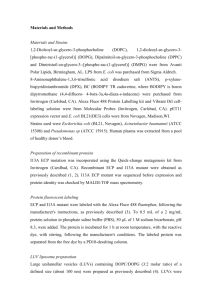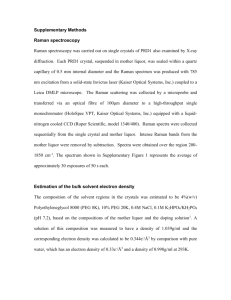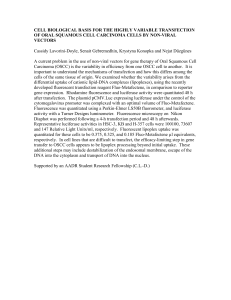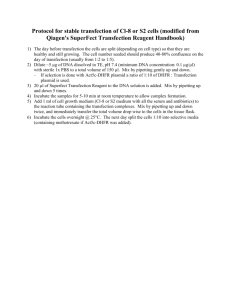1. Transfection efficiency and cell viability
advertisement
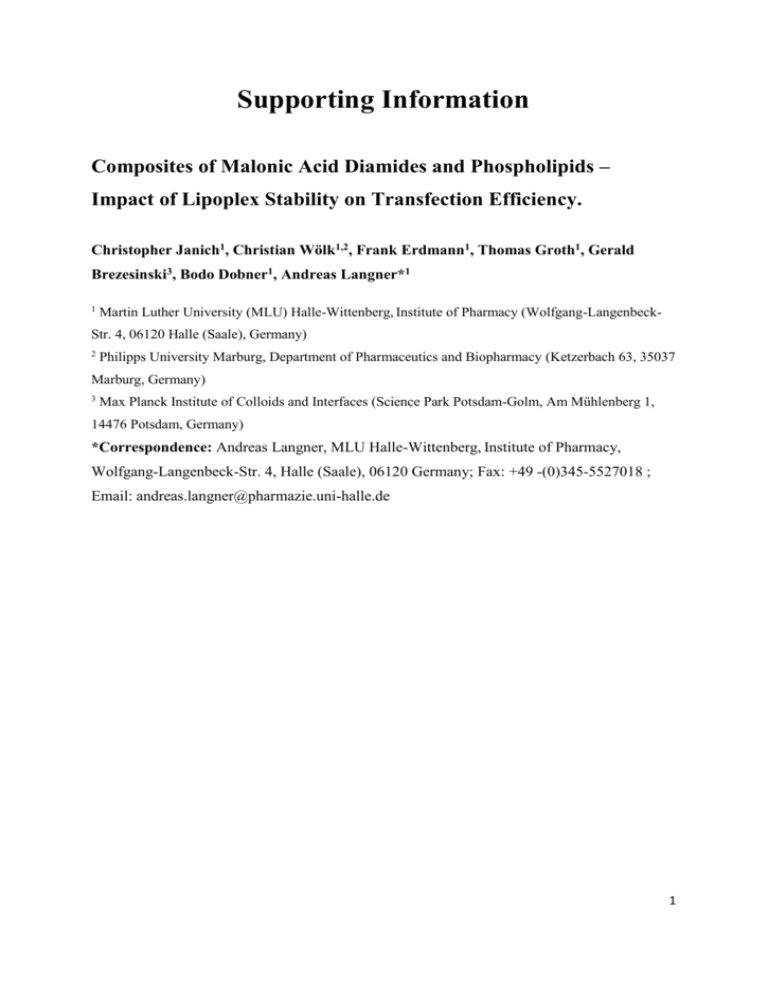
Supporting Information Composites of Malonic Acid Diamides and Phospholipids – Impact of Lipoplex Stability on Transfection Efficiency. Christopher Janich1, Christian Wölk1,2, Frank Erdmann1, Thomas Groth1, Gerald Brezesinski3, Bodo Dobner1, Andreas Langner*1 1 Martin Luther University (MLU) Halle-Wittenberg, Institute of Pharmacy (Wolfgang-Langenbeck- Str. 4, 06120 Halle (Saale), Germany) 2 Philipps University Marburg, Department of Pharmaceutics and Biopharmacy (Ketzerbach 63, 35037 Marburg, Germany) 3 Max Planck Institute of Colloids and Interfaces (Science Park Potsdam-Golm, Am Mühlenberg 1, 14476 Potsdam, Germany) *Correspondence: Andreas Langner, MLU Halle-Wittenberg, Institute of Pharmacy, Wolfgang-Langenbeck-Str. 4, Halle (Saale), 06120 Germany; Fax: +49 -(0)345-5527018 ; Email: andreas.langner@pharmazie.uni-halle.de 1 Content 1. Transfection efficiency and cell viability ............................................................................................. 3 1.1 Transfection efficiency and cell viability values of two phospholipids (DOPE, DPPC) in mixtures with the cationic lipids OH4 and TH4 on A549 cells ............................................................................ 3 1.2 Transfection efficiency and cell viability values for different amounts of Lipofectamine 2000® on LLC-PK1 and HeLa cells. ....................................................................................................................... 4 2. Mass weighted size distribution curves of lipoplexes determined by DLS using different phospholipids (DOPE, DPPC) in mixtures with the cationic lipids OH4 and TH4 and pDNA ................... 5 3. FCS dependent DNA release assay of different lipoplexes at pH 7.3. ................................................. 6 4. IRRA spectra of Langmuir monolayers of the lipid mixtures on subphase with and without DNA and the corresponding reference spectra. ..................................................................................................... 7 5. ζ-potential of the different lipoplexes containing DOPE DOPC DPPC as helperlipids ......................... 8 6. Synthesis of transfection lipid ATTO490LS-OH4: ................................................................................ 8 7. DNA-release assay induced by anionic membrane lipids:................................................................... 8 8. Determination of the charge density: ................................................................................................. 9 9. Serum- displacement assay: .............................................................................................................. 10 2 1. Transfection efficiency and cell viability 1.1 Transfection efficiency and cell viability values of two phospholipids (DOPE, DPPC) in mixtures with the cationic lipids OH4 and TH4 on A549 cells Figure S1: Transfection efficiency measured by detecting eGFP fluorescence and the corresponding cell viability values for different lipid dispersions by varying the N/P ratio (1.5, 2.0, 2.5, 3.0, 4.0) – in complex with peGFP-C2-DNA in A549 cells (n = 12); published previously [1]. 3 1.2 Transfection efficiency and cell viability values for different amounts of Lipofectamine 2000® on LLC-PK1 and HeLa cells. Figure S2: Transfection efficiency measured by detecting eGFP fluorescence and the corresponding cell viability values for different amounts of Lipofectamine 2000® (LP2000) per well and a fixed amount of 100 ng per well peGFP-C2 DNA on HeLa cells (n = 12). 4 2. Mass weighted size distribution curves of lipoplexes determined by DLS using different phospholipids (DOPE, DPPC) in mixtures with the cationic lipids OH4 and TH4 and pDNA Figure S3: Mass weighted size distribution curves of lipoplex mixtures in the different N/P ratios (1.5, 2.0, 2.5, 3.0, 4.0) consisting of the helper lipid DOPE and the cationic lipid OH4 (A) and TH4 (B) and the corresponding size distributions of the lipoplexes with the helper lipid DPPC and the cationic lipid OH4 (C) and TH4 (D) in MES-buffer 10 mM pH 6.5 determined by DLS at 25°C. For each sample 2.5 µg of peGFP- DNA was used. The size distribution curves are vertically shifted for clarity. 5 3. FCS dependent DNA release assay of different lipoplexes at pH 7.3. Figure S4: Effect of 10% FCS on different lipoplexes at N/P 4 containing 0.708 µg peGFPC2 DNA measured as EtBr fluorescence of released DNA as a function of time in 20 mM HEPES buffer pH 7.3 at 37°C. . 6 4. IRRA spectra of Langmuir monolayers of the lipid mixtures on subphase with and without DNA and the corresponding reference spectra. Figure S5: IRRA spectra of Langmuir-monolayers of the lipid mixtures OH4:DOPE, OH4:DPPC, TH4:DOPE, and TH4:DPPC on MES-buffer pH 6.5 in presence (black lines) and absence (blue lines) of DNA (0.1 mM nucleotides) in the subphase as well as their difference spectra (red lines). 7 5. ζ-potential of the different lipoplexes containing DOPE DOPC DPPC as helperlipids Figure S6: ζ-potential of the different lipoplexes as a function of N/P ratio in MES-buffer 10 mM pH 6.5 determined by DLS at 25 °C. For each sample 2.5 µg of peGFP- DNA was used. 6. Synthesis of transfection lipid ATTO490LS-OH4: Synthesis of fluorescence labeled transfection lipid ATTO490LS-OH4: Lipid OH4 (1,26 mg, 1.51 µmol) was dissolved in dry dichloromethane (500 µL) and the fluorescence label ATTO 490LS as NHS ester (1.0 mg, 1.26 µmol, dissolved in 200 µL CH2Cl2) (ATTO-Tec GmbH, Siegen, Germany), and triethylamine (0.19 mg, 1,89 µmol) were added. The mixture was stirred for 12 h at room temperature under argon atmosphere. Afterwards, the solvent was evaporated under reduced pressure and the labeled lipid ATTO490LS-OH4 was purified by preparative layer chromatography (PLC) using glass plates (20×20 cm) with silica gel 60, 0.5 mm (Merck, Darmstadt, Germany) and chloroform/methanol/ammonia (65/35/5, v/v/v) as eluent. By dissolving and centrifugation of the silica gel, the purified lipid was obtained in several steps. 7. DNA-release assay induced by anionic membrane lipids: Anionic vesicle displacement assay: As anionic vesicles a mixture of DOPC:DOPE:DOPS:Chol, 40:20:20:15, w:w:w:w buffered in 20 mM acetat pH 5.2 or in 20 mM HEPES pH 7.3 were used. 40µL of lipoplex solutions (2.83 µg pDNA, N/P 4) were prepared. 10 μL lipoplex solution different amounts of anionic vesicle solutions were added, adjusted with 20 mM acetate or HEPES buffer to 20 µL and incubated for 1 h. The respective amounts of the anionic vesicles depending on different -/+ (anionic lipid/cationic lipid) charge ratios in relation to the respective lipid mixture. For anionic vesicles -/+ charge ratios (5, 8, 10) were chosen. Thereafter, these mixtures were briefly mixed with 4 µL of blue/orange 6x 8 loading dye (G190A) and 20 µL of the mixture were electrophoresed and visualized as described in the materials and methods chapter of the article. Figure S7: Effect of anionic vesicles (MM= DOPC:DOPE:DOPS:Chol, 40:20:20:15 on different lipoplexes at N/P 4 containing determined by gel-retention assay. A) pH 5.2 B) pH 7.3. The numbers are the uses ˗/+ (anionic lipid/cationic lipid) charge ratios. 8. Determination of the charge density: The calculation of the charge density was based on a method described by Lin et al. using the following equations [2]. (1) NNH2 = number of NH2 groups in the cationic lipid (3 NH2 groups for OH4 or TH4) Qeff = effective charge of the lipoplex CC = point of charge compensation (IEP or endpoint of the EtBr assay) (2) 9 σ = charge density Nl = total number of lipids corresponding to one cationic lipid molecule in the mixture = 2 for all investigated lipid formulations in a 1:1 (n:n) ratio Amol = apparent molecular area of lipid mixtures determined from Langmuir isotherms at π = 30 mN m-1 For the discussion of the influence of the charge density on the TE, only the mixtures with the helper lipid DOPE were used due to the good miscibility with the cationic lipid components. The calculations for lipoplexes which include DPPC as a helper lipid and mix only partially should be used carefully (in parentheses in table 3). A lipid demixing, which was demonstrated in previous studies for the DPPC-containing lipoplexes, results in domains with higher or lower charge densities than calculated by the assumption of total miscibility. [1] 9. Serum- displacement assay: 40 µL of lipoplex solutions (2.83 µg pDNA, N/P4) were prepared as described above. 5 μL lipoplex mixture were completed with 5 µL DMEM containing 10% ,20% or 30 % FCS to reach a final serum concentration of 5%,10% or 15%. Thereafter these mixtures were briefly mixed with 2 µL of blue/orange 6x loading dye (G190A) and were electrophoresed and visualized as described above (Gel-retention Assay). Figure S8: Effect of DMEM medium with different content of FBS on different lipoplexes at N/P 4 containing determined by gel-retention assay. A) pH 5.2 B) pH 7.3. The numbers indicate the amount of FBS in DMEM in %. 10 Reference: [1] Janich, C., Wölk, C., Taßler, S., Drescher, S., Meister, A., Brezesinski, G., Dobner, B., Langner, A.: Composites of malonic acid diamides and phospholipids – Structural parameters for optimal transfection efficiency in A549 cells, European Journal of Lipid Science and Technology. 2014, 116, 1184-1194. [2] A.J. Lin, N.L. Slack, A. Ahmad, C.X. George, C.E. Samuel, C.R. Safinya, ThreeDimensional Imaging of Lipid Gene-Carriers: Membrane Charge Density Controls Universal Transfection Behavior in Lamellar Cationic Liposome-DNA Complexes, Biophysical Journal, 2003, 84, 3307-3316. 11

